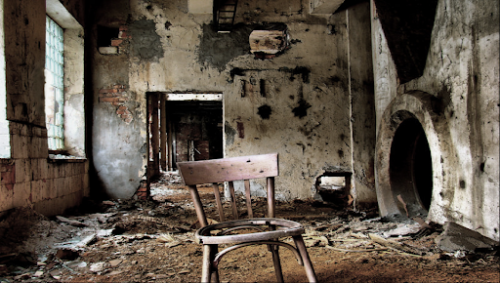
A whopping 25% of GCSE English Language marks are assigned to creative writing – such as a story or description in 45 minutes. Always a tall order as it needs to have all the right ingredients to WOW the examiner.
For starters, the question usually reads like this:
You have been invited to take part in a creative writing competition judged by people your own age. Write a description of this picture.
With just 45 minutes allocated time, you need to get your skates on fast.
Rule 1: PLAN IDEAS FIRST
- BRING THE PICTURE TO LIFE in your head as if it is a movie scene. Annotate the picture with sounds, sensations, light, moving things, noises from far away, weather outside. Something may feel physically hard or spiky underfoot; there might be a perishingly cold wind seeping through walls or window cracks.
- BOX OFF FOUR SECTIONS – perhaps the panoramic scene/the background. Then zoom into two other areas as you approach the foreground: the walls, the window. ZOOM RIGHT IN: see the shards of glass on the floor, or curly moss stretching up the wallpaper etc. Then, perhaps cut to the foreground: the chair or the tunnel. These will help you to set the scene and establish atmosphere at the start.
- Focus on ACTION/SWITCH FOCUS/ZOOM IN ON SOMETHING NEW. Perhaps the focus switches to the darkened tunnel into the next room – add some movement.
- Next, ADD A TWIST/A CHANGE/A DISCOVERY/A FLASHBACK. Dialogue could work here if a new character enters the scene. It’s also an opportunity to change the atmosphere. If sun streamed though the window at the start, dark clouds could have darkened the room. Rain might start punching the window. Always great to pop some personification in there!
- WRAP IT UP. Short stories or descriptions can end on a cryptic note or a cliff-hanger. Perhaps an unexpected twist or narrator’s reflection on the scene.
RULE 2: ADD CREATIVE WRITING TECHNIQUES:
- USE MASSIVE DEVICES. Add: Metaphors, Adjectives, Senses, Superlatives, Imagery, Verbs, Emotion. Strong creative writing relies on you weaving a range of language techniques into your work to create different effects.
- VARY SENTENCE STRUCTURES. Start sentences with: verbs, prepositions, adjective/noun combos. Follow a complex sentence with a short, punchy one to increase tension/change pace.
- BE ORIGINAL. No fluffy clouds looking like sheep, or wooden doors that creak open. Instead practise metaphors/personification writing to achieve original effects. Clouds might look like a sea of metallic-grey mountains if a storm is on the way, for instance. Perhaps blackened soot might crawl its inky fingers across every particle of plaster. It’s ALL about the detail.
Of course, this is just the start to becoming a fabulous creative writer. Something our experienced English teachers here at 121 Home Tutors always advise is to read. As many different genres as you can.
Check out the BBC Sounds app too. There’s all sorts of novels, short stories and podcasts to listen to.
Be inspired … become a better writer
Ready to transform your writing capabilities? Please get in touch with our tutor team. With a fantastic mix of tutors local to Manchester and Cheshire, or tutors available online, we can help you not only achieve your target grades , but smash them.
Just drop us a line here to start the ball rolling.
Tags: annotate, creative writing techniques, English Language GCSE, English teachers, how to be a brilliant writer, online English tutor, original writing, personification, read more, sentence structures


